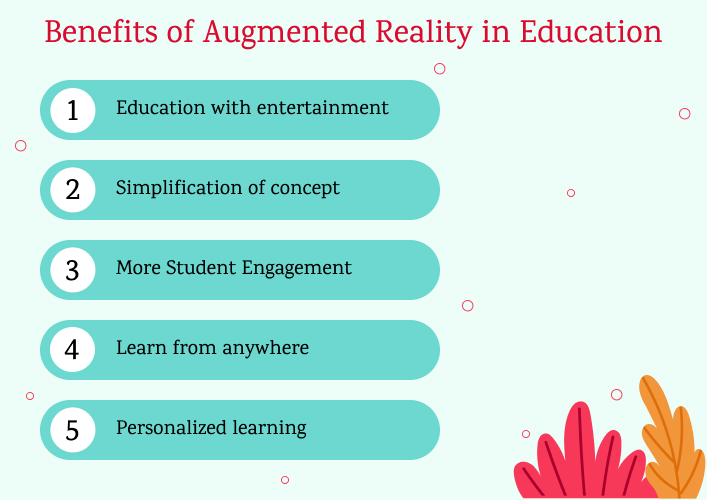Benefits of Augmented Reality in Education

Augmented Reality trends will have a major impact on the academic world, as they have on other fields of study. Let’s see the major benefits of AR in detail.
Education with entertainment
Visual learning toolkits accelerate student understanding. Visual information makes up 90% of all sensory data sent to the brain. Humans are creatures of habit and one of those habits is to learn via observation, which supports the use of Augmented Reality in teaching. Lessons that entail immersive experiences would be more memorable for students and would spur more active learning in the classroom.
Simplification of concept
If you were to introduce AR and then let pupils study independently, however, everyone would be able to dive right into the experience thanks to 3D modeling. With the help of AR applications, students may study at their own speed without feeling rushed. Additionally, with the help of the AR education app development company, educators may tailor their lessons to the specific needs of their students in order to maximize their learning outcomes.
More Student Engagement
Using AR, students may engage with virtual information superimposed on their physical surroundings. Students are able to explore topics, solve issues, and control things because of this interaction, which makes learning more interesting. AR can turn static textbooks and lectures into dynamic, multimedia-rich experiences. Text, images, videos, and 3D models can all be integrated into AR learning materials, making them more engaging and interactive. Furthermore, rewards, challenges, and leaderboards are just some of the gamification components found in many AR educational applications.
Learn from anywhere
As AR technology improves, it will be used in new and creative ways, allowing students to be better prepared for the problems of the future. The use of AR in distance and online education has completely transformed the learning experience. By creating immersive experiences, it helps bridge the gap between physical and virtual classrooms.
Personalized learning
AR applications can analyze a student’s progress and preferences and deliver content tailored to their learning style. For instance, if a student learns best through visual aids, AR can provide 3D models, animations, or interactive diagrams to enhance comprehension. AR apps can adjust the difficulty level of tasks or questions based on the learner’s performance. If a student is struggling with a concept, the AR system can provide additional explanations or simpler exercises, ensuring that they don’t get discouraged by overly challenging material.
Implementing Augmented Reality in the Education Sector
There are many ways through which augmented reality can be implemented in the education sector. Some of them are mentioned below:
- Augmenting Homework: Teachers can provide their pupils with AR-enabled worksheets to complete at home. A few questions about a certain subject could be included in a worksheet. Students who are stuck on a problem may scan the worksheet using the AR app for hints on how to solve it.
- Turning Concepts to Reality: Using 3D modeling and object identification, AR may transform complex ideas into interesting courses and make learning fun. For example, in a biology class, the amount of information that may be gained by each student doing an operation will increase dramatically. Apps like AR Atom Visualizer are such examples.
- Augmented Classroom: After scanning a textbook, the AR app can provide students with visual representations of abstract concepts. Having students get hands-on experience with a topic’s foundational concepts in the class has the potential to transform value addition into an enjoyable, outside-of-class activity. Augmented reality has the potential to significantly enhance education in the vital STEM (science, technology, engineering, and mathematics) fields.
Conclusion
The use of AR in education has far-reaching and varied effects. The immersive, engaging, and individually tailored learning experiences that AR technology can provide have the potential to completely transform the educational system. Augmented reality’s major effects on education include more interest, better retention, more personally relevant lessons, and wider access.
FAQs
How does AR enhance learning?
What subjects benefit most from AR in education?
Is AR accessible to all students, including those with disabilities?
Are there any drawbacks to using AR in education?
How can educators incorporate AR into their classrooms?
Ravi Bhojani is the Chief Marketing Officer (CMO) at Alian Software, where he spearheads the company’s marketing strategies and drives its brand presence in the competitive IT services landscape. With over a decade of experience in the technology and marketing sectors, Ravi has consistently demonstrated his ability to blend innovative marketing techniques with deep industry knowledge to deliver outstanding results.